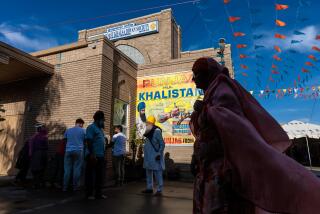In Sikkim Vote, It’s the Free Roof, Stupid
- Share via
NAMTHANG, India — There are few good jobs and a lot of leaky roofs in Sikkim, which is usually good for the ruling party on election day.
This Himalayan state in northeast India has none of the high-tech industries that are propelling India’s economy into the 21st century, so its people rely on the ruling Sikkim Democratic Front to provide free utilities and corrugated tin roofs. They are paid for out of the $730 million the state receives in federal grants each year.
But opposition politicians say the party is misusing those federal tax dollars to frighten anyone tempted to vote for the opposition.
“They warn the people that ‘if you don’t vote for us, you won’t get the freebies,’ ” said Biraj Adhikari, a candidate for Parliament from the opposition Congress Party, after a recent campaign speech in this south Sikkim town. “The ruling party is intimidating voters in many ways. So they get scared.”
As she cast her vote for the SDF on Monday, the final day of voting in India’s general election, Mankumari Gurung said she had little interest in national politics.
It is the rainy season in her western village of Pathing, and Gurung, 62, said the only issues on her mind were her free electricity and water, and those tin sheets for her roof.
“That’s why I am going to vote for the ‘umbrella,’ ” the symbol of the SDF, said Gurung, who sat in the shade of a tree 5,000 feet up a terraced mountainside.
When the votes are tallied in India’s national election Thursday, the whole state of Sikkim will elect only one of the 545 representatives in Parliament’s lower house.
So Sikkim doesn’t count for much in Indian politics.
But it is a good place to see how the wheels of the world’s largest democracy are often greased.
This is a national election dominated by local issues. Since no single party seems popular enough to win on its own, regional parties are likely to decide the next government.
Exit polls in the three-week election, which began April 20, suggest Prime Minister Atal Behari Vajpayee’s Bharatiya Janata Party and opposition leader Sonia Gandhi’s Congress Party will both fall short of a majority. They are furiously trying to attract smaller allies, which is likely to further shift power from New Delhi to state capitals, a trend that began in the mid-1990s when almost four decades of Congress Party rule ended.
More than 675 million Indians are eligible to choose from thousands of candidates representing at least 40 political parties.
For the first time, all of India’s voters are casting ballots electronically, by pressing buttons marked with party symbols on more than 175,000 voting machines.
Vajpayee called the election six months early, hoping to glide to victory on India’s soaring economy.
He campaigned on a slogan of “India Shining,” claiming that he was leading the country into a new era of prosperity and international prestige.
But while India’s huge middle class reaps the benefits of an economy growing at around 8% annually, more than 350 million Indians are so desperately poor that they live on less than $1 a day.
Gandhi, the Italian-born widow of assassinated Prime Minister Rajiv Gandhi, told voters that Vajpayee had left large parts of the country mired in poverty and communal hatred.
With around 500,000 people in a country of more than 1 billion, Sikkim is a tiny state. It makes good Gouda cheese and beer, and offers tourists spectacular mountain treks, but the state’s economy would collapse without the federal money from New Delhi.
Adhikari, the Congress Party’s federal candidate in Sikkim, said corrupt local politicians pocket much of that largess and deny Sikkim’s people real development.
Sujit Chakravarty, publisher and editor of Sikkim’s Weekend Review newspaper, added that the SDF is also trying to roll back political protections for minorities that were guaranteed when Sikkim, formerly a Buddhist kingdom, was annexed by India in 1975.
Both government critics insist that the feudal system that dominated Sikkim for centuries still influences its politics.
“The corrugated tin sheets, and housing loans, actually come from grants from the central government,” the editor said.
“But the [state] chief minister has been going around saying, ‘This is money I’m giving you,’ as if he’s shelling it out from his own pocket, which is a lie.”
Nakul Rai, the SDF candidate for India’s Parliament, denied claims that his party uses its control of the state government to influence voting in the national election.
He said that the handouts of tin roofing, which began in 1994, are carried out in phases, so anyone who hasn’t received a new roof will probably get it later. Cash grants will also be handed out after the election, he added.
Down a winding mountain track from the SDF stronghold of Pathing, a sole Congress Party flag flew from a wooden pole above Karama Ongmu Bhutia’s house. The 30-year-old villager, a member of the Bhutia minority, said she is taking a risk by showing her support for the opposition.
“There has been no torture from the SDF so far, but being Congress supporters, we have a constant fear of attack,” she said. “We live close to the road, so that makes us more vulnerable.”
Bhutia said she used to vote for the ruling SDF but switched to Congress because the state chief minister didn’t give her a $230 grant due anyone in Sikkim who lives below the poverty line.
Bhutia says she has to pay for electricity that all her neighbors, who are SDF supporters, get for free. Her family also pays more for rice because the state won’t give them a benefits card.
“The future of our children is not bright,” she said.
More to Read
Sign up for Essential California
The most important California stories and recommendations in your inbox every morning.
You may occasionally receive promotional content from the Los Angeles Times.












